#ca. 1336 b.c.
Text

Head of the God Amun
Ca. 1336–1327 B.C.
New Kingdom, post-Amarna Period.
From Upper Egypt, Thebes; From Egypt.
Amun was a major ancient Egyptian deity who appears as a member of the Hermopolitan Ogdoad. Amun was attested from the Old Kingdom together with his wife Amunet. With the 11th Dynasty (c. 21st century BC), Amun rose to the position of patron deity of Thebes by replacing Montu.
After the rebellion of Thebes against the Hyksos and with the rule of Ahmose I (16th century BC), Amun acquired national importance, expressed in his fusion with the Sun god, Ra, as Amun-Ra (alternatively spelled Amon-Ra or Amun-Re).
Amun-Ra retained chief importance in the Egyptian pantheon throughout the New Kingdom (with the exception of the "Atenist heresy" under Akhenaten). Amun-Ra in this period (16th to 11th centuries BC) held the position of transcendental, self-created creator deity "par excellence"; he was the champion of the poor or troubled and central to personal piety. With Osiris, Amun-Ra is the most widely recorded of the Egyptian gods.
As the chief deity of the Egyptian Empire, Amun-Ra also came to be worshipped outside Egypt, according to the testimony of ancient Greek historiographers in Libya and Nubia. As Zeus Ammon and Jupiter Ammon, he came to be identified with Zeus in Greece and Jupiter in Rome.
#Head of the God Amun#Ca. 1336–1327 B.C.#New Kingdom post-Amarna Period#granodiorite#sculpture#egyptian sculpture#ancient artifacts#archeology#archeolgst#history#history news#ancient history#ancient culture#ancient civilizations#ancient egypt#egyptian history#egyptian art
141 notes
·
View notes
Text
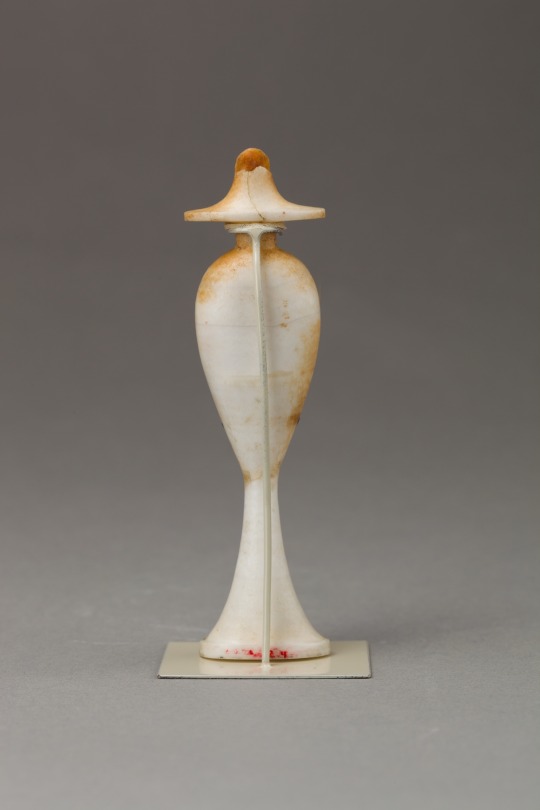


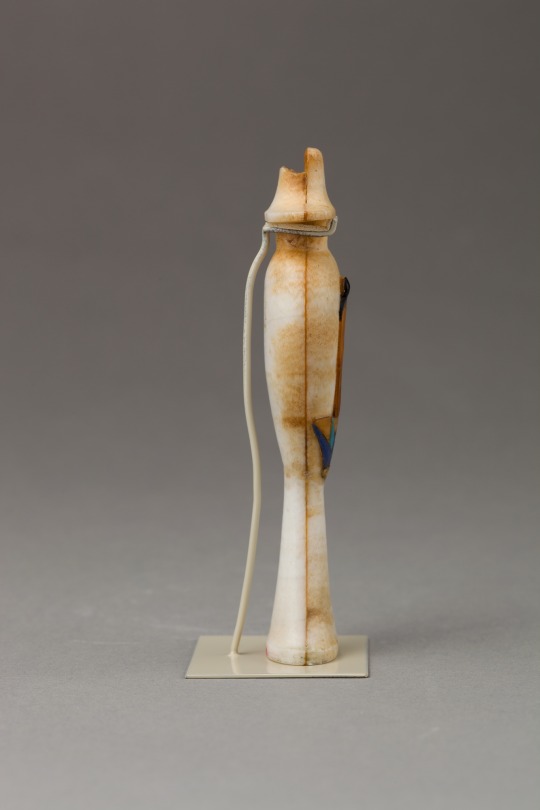
~ Perfume bottle in the shape of a hes-vase inlaid with the figure of a princess.
Period: New Kingdom, Amarna Period; 18th Dynasty; Reign of Akhenaten
Date: ca. 1353–1336 B.C.
Place of origin: Egypt; Possibly from Upper Egypt, Thebes
Medium: Travertine (Egyptian alabaster), carnelian, obsidian,gold, and colored glass inlay.
#ancient#ancient art#history#museum#archeology#ancient egypt#ancient history#archaeology#egyptology#egyptian#egypt#perfume bottle#hes-vase#princess#amarna period#18th dynasty#new kingdom#Akhenaten#thebes#ca. 1353 b.c.#ca. 1336 b.c.
763 notes
·
View notes
Text

Water Bottle from Tutankhamun's Embalming Cache
Egypt, New Kingdom ca. 1336–1327 B.C.
146 notes
·
View notes
Photo
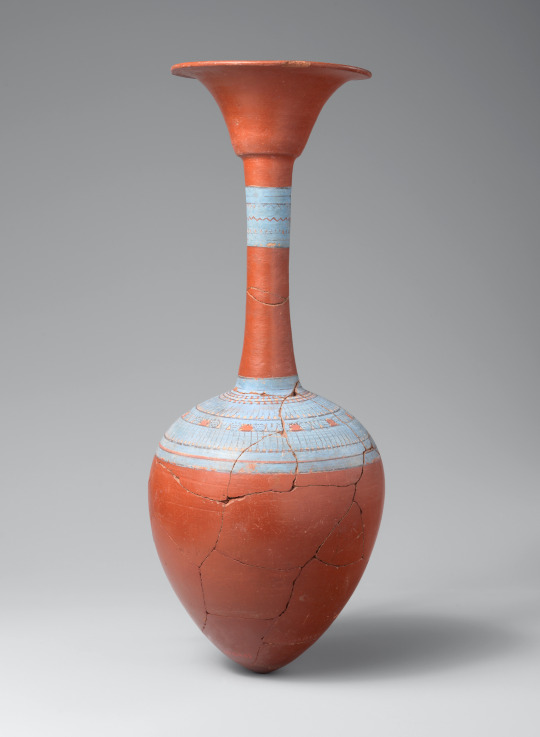
Water Bottle from Tutankhamun's Embalming Cache. New Kingdom, ca. 1336–1327 B.C.
(via Metropolitan Museum of Art)
256 notes
·
View notes
Text

Egyptian
Fragment of a Queen's Face
ca. 1390-1336 B.C.
#egyptian art#ancient egypt#ancient art#ancient history#ancient people#ancient culture#artifacts#antiquities#aesthetic#beauty#statue#egyptian history#egyptian culture#egyptian aesthetic#art history#aesthetictumblr#tumblraesthetic#tumblrpic#tumblrpictures#tumblr art#tumblrstyle#artists on tumblr
240 notes
·
View notes
Photo

Relief Depicting the Nurse Tia ca. 1353–1336 B.C. New Kingdom, Amarna Period
“The block evokes a scene of the king before a crowd. On the right, an elegant hand dangles alongside the thigh of a royal male, surely Akhenaten. Behind him is a woman labeled "the nurse of the king’s daughter Ankhesenpaaten, Tia." Tia faces to the right and holds small loaves to cajole the restive young princess, whose garment is just visible on the far right where she stands for the court ceremony.”
in The Met, gallery 121
#nurse tia#ankhesenamun#akhenaten#taking a moment to think about hoe this is a depiction of the woman who looked after little ankhesenpaaten and having some Feelings#ancient egypt#archaeology#amarna period#18th dynasty
73 notes
·
View notes
Text
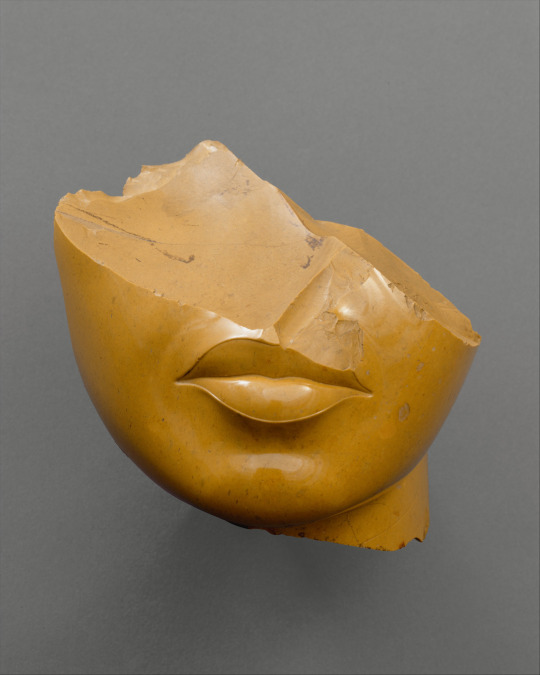
fragment of a queen's face, ca. 1353–1336 b.c.
4 notes
·
View notes
Text

Face from a Composite Statue, probably Queen Tiye. New Kingdom, Amarna Period ca. 1353–1336 B.C, quartzite.
1 note
·
View note
Text

Perfume bottle in the shape of a hes-vase inlaid with the figure of a princess. New Kingdom, Amarna Period; 18th Dynasty; Reign of Akhenaten, Egypt, ca. 1353–1336 B.C.
via theancientwayoflife
5 notes
·
View notes
Photo


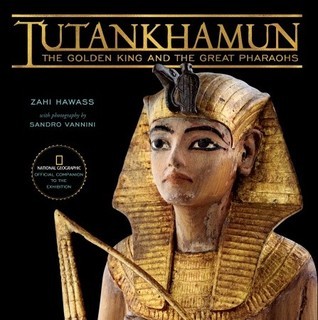

More Book Recs: Centennial Anniversary of King Tut’s Tomb Discovery
Tutankhamun’s Tomb by Susan J. Allen
This richly illustrated book of vintage photographs commemorates one of the most memorable episodes in the history of archaeology: the discovery and exploration in 1922 of the tomb of the ancient Egyptian pharaoh Tutankhamun (Dynasty 18, ruled ca. 1336–1327 B.C.). These photographs, documenting every stage in the process of discovery, were taken by the renowned archaeological photographer Harry Burton. Burton was a staff member of the Metropolitan Museum Egyptian Expedition when he was “lent” to Howard Carter, the famed excavator of Tutankhamun’s tomb.
From the rock-cut steps leading down to the entrance passage, to the opening of the sealed chambers inside, to the first view of the contents of the tomb and the removal of the objects, Burton’s beautiful black-and-white photographs show thousands of the richly made and decorated objects found in the tomb. Carefully reproduced from Burton’s original prints, the photographs are accompanied by new descriptive text written by two prominent Egyptologists with extensive knowledge of the history of Tutankhamun and the contents of his tomb.
Tutankhamun: His Tomb and Its Treasures by I.E.S. Edwards
Never before in the literature - or the photography - of Egyptology has a book displayed so richly the splendors of ancient Egyptian art. Here are the legendary treasures of Tutankhamun's tomb - in a magnificent volume expanded from the unprecedented Metropolitan Museum - Egyptian Government Exhibition.
Tutankhamun: The Golden King and the Great Pharaohs by Zahi Hawass
Mysterious boy king Tutankhamun returns to the U.S. in 2008, bringing rare treasures never before seen outside Egypt. For the millions of fans wanting a keepsake and chronicle of this magnificent new exhibition, this book will delight. Created by world-renowned art historians under the guidance of Zahi Hawass - director of Egypt’s Supreme Council of Antiquities and a well-known media personality - it surveys 3,000 years of ancient Egyptian history by focusing on the lives and lifestyles of great pharaohs. Master photographer Sandro Vannini spotlights every dazzling artifact, using an innovative technique that makes the image jump off the page. Featuring more than 120 treasures, a dozen evocative landscape and archaeology photos, and illuminating text, this book makes palpable the excitement, riches, and mysteries of ancient Egypt.
The First Pharaohs by Aidan Dodson
The five centuries that followed the unification of Egypt around 3100 BC - the first three dynasties - were crucial in the evolution of the Egyptian state. During this time all the key elements of the civilization that would endure for three millennia were put in place, centered on the semidivine king himself. The First Pharaohs: Their Lives and Afterlives looks at what we know about the two-dozen kings (and one queen-regent) who ruled Egypt during this formative era, from the scanty evidence for the events of their reigns, through to their surviving monuments. It also considers how they were remembered under their successors, when some of the earliest kings' names were attributed to allegedly ancient ideas and events, and the ways in which some of their monuments became tourist attractions or were even wholly repurposed.
#king tut#tutankhamun#centennial anniversary#nonfiction#history#ancient egypt#book recs#book recommendations#reading recs#reading recommendations#library books#TBR pile#tbr#to read#booklr#book tumblr
9 notes
·
View notes
Photo

Funerary Figure of Akhenaten
New Kingdom, Amarna Period
Dynasty 18
Ca. 1353–1336 B.C.
H. 27 × W. 8.2 × D. 7 cm (10 5/8 × 3 1/4 × 2 3/4 in.).
During the reign of Akhenaten, many funerary figures were made for the king in a variety of materials and styles. However, none of these seems to have been inscribed with chapter six of the Book of the Dead, the shabti spell that compelled the figure to perform work for its owner in the afterlife. This is the only complete funerary figure of Akhenaten that is known. In this example, the king wears royal beard and a head covering known as the khat with a cobra, the protector of the king, at the brow.
The Met Fifth Avenue.
#Funerary Figure of Akhenaten#New Kingdom Amarna Period#Dynasty 18#Ca. 1353–1336 B.C.#granite#granite sculpture#ancient artifacts#archeology#archeolgst#history#history news#ancient history#ancient culture#ancient civilizations#ancient egypt#egyptian history#egyptian art#the met fifth avenue
22 notes
·
View notes
Photo
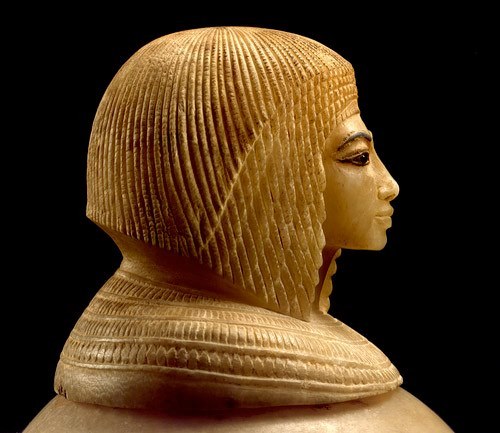
Alabaster canopic jar lid with glass and stone inlays, New Kingdom, Dynasty 18, late reign of Akhenaten, ca. 1340–1336 B.C. Western Thebes, Egypt.
Canopic jars were used to store the four internal organs that were removed during mummification. Although intended for a funerary context, the face on this canopic jar lid was carved by a master with the skill and care one might expect in a more public portrait. - metmuseum.org
20 notes
·
View notes
Text
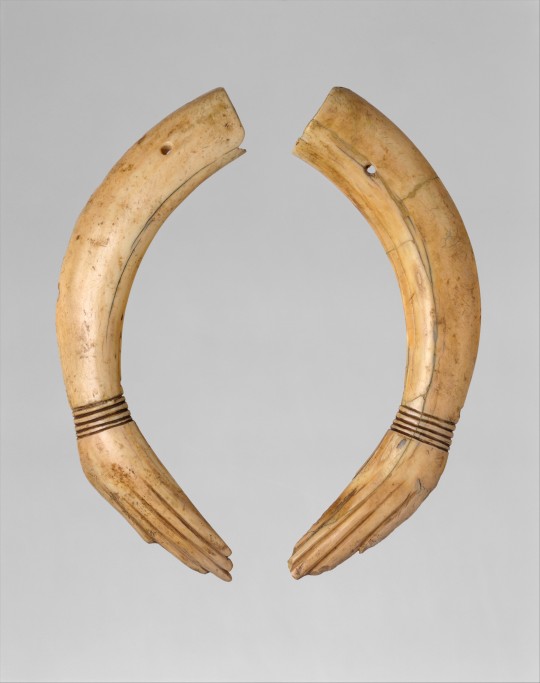
Pair of Clappers
Egypt, New Kingdom, Amarna Period ca. 1353–1336 B.C.
These clappers in the form of human hands were carved from a single hippopotamus tusk that was split in half. Such percussion instruments were used to keep time during dances or as part of a musical ensemble. These examples, however, were found in a miniature coffin at Amarna and seem to have been part of an offering.
25 notes
·
View notes
Photo

Attendants in a Procession
Egypt, ca. 1353–1336 B.C.
New Kingdom, Amarna Period
This block comes from a scene of the king and the royal family processing to the temple, a popular subject in the reliefs at Amarna. The family is often accompanied by attendants carrying fans and sunshades, like the four men whose heads are preserved on the block at the upper left. The men appear to stand beside the king’s chariot, which the king himself drove; the reins extending between the chariot box and the horse’s necks may be seen across the bottom of the block.
1 note
·
View note
Text
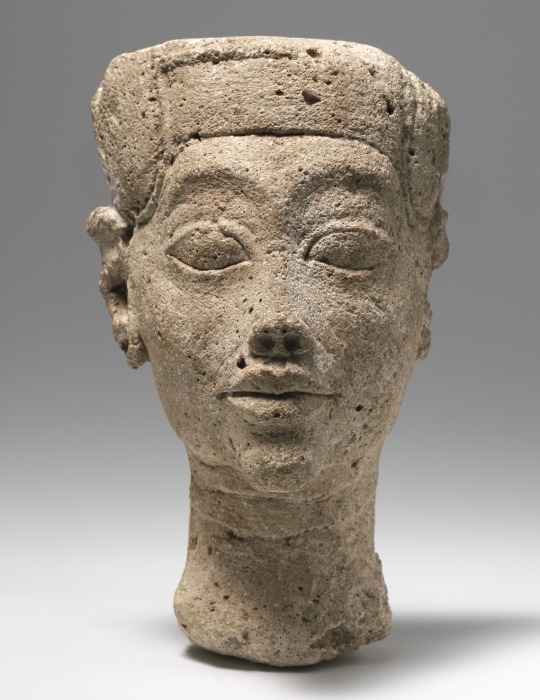
Egyptian, Head of Akhenaten or Nefertiti, New Kingdom, Amara Period, ca. 1353-1336 B.C.
#ancient egyptian art#egyptian art#egyptian history#egyptian aesthetic#egyptian king#egyptian queen#ancient art#ancient people#ancient culture#aesthetic#beauty#ancient statue#art history#aesthetictumblr#tumblraesthetic#tumblrpic#tumblrpictures#tumblr art#tumblrstyle#artists on tumblr#egyptian#egypt
25 notes
·
View notes
Text

Statue of two men and a boy that served as a domestic icon
From Egypt, reign of Akhenaten, ca. 1353–1336 B.C.
In the Met Museum
0 notes